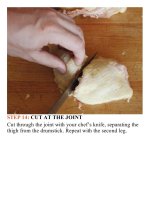The food lab better home cooking through science ( PDFDrive ) 1076
Bạn đang xem bản rút gọn của tài liệu. Xem và tải ngay bản đầy đủ của tài liệu tại đây (177.64 KB, 2 trang )
at relatively low temperature. Bound water, on the other
hand, requires significantly more energy and a higher
temperature before it escapes. Heat a potato slice up to
275°F, and despite the fact that the temperature is well
above the boiling point of water, some of the bound water
willremaininsideuntilyougetitevenhotter.So,thehotter
you fry a food, the more water will escape, and the more
roomisleftforoiltobeabsorbed.
This was all pretty shocking news to me, so I did what
anygoodskepticwoulddo:Itestedit.Ifilledmywokwith
two quarts of oil and weighed it on a precise scale. Next, I
heated the oil to 275°F and maintained that temp while I
friedchickenforafixedperiodoftime.Afterremovingthe
chicken, I weighed the oil remaining in the wok. I then
repeatedthetest,thistimemaintainingtheoilat325°Fwhile
cookingthechicken.Afterrepeatingthetestafewtimes,the
resultsconfirmedwhatIhadread:thehotterthetemperature
themoreoilthechickenabsorbed.
There’s an explanation commonly given for why foods
cooked at a higher temperature supposedly absorb less fat:
the outward pressure of water vapor rapidly escaping from
the food prevents the influx of oil.This may be true while
the food is actually in the hot oil, but as soon as it’s
removed, its temperature drops rapidly. What once was
positive pressure being exerted from inside the food
reversesitselfandresultsinapartialvacuumwithinamatter
of milliseconds. Rather than pushing water vapor out, the
food rapidly sucks the oil clinging to its surface into its
interior. Even the fastest fry cook in the world can’t drain
his onion rings fast enough to stop this influx of oil. Up to
70 percent of the oil absorbed by fried foods is absorbed
withinthefirstfewsecondsafteritcomesoutofthefryer.
Butdespitehavingabsorbedlessoil,thechickencooked
at 275°F, which was limp and oily, tasted much greasier
thanthecrispchickencookedat325°F.Turnsoutthatwhat
wedescribeas“greasy”actuallyhasnothingtodowiththe
total amount of grease in a food—it’s just an illusion.
Rather, it’s the combination of surface oil and a mushy,
moist breading or batter in our mouths that gives us the
sensationofgreasinessorheaviness.Crisp,well-friedbatter,
breading, or chicken skin may contain more fat, but it sure
doesn’ttastethatway.
Lesson learned: When frying, cooking at a higher
temperatureisabsolutelyessentialifyouwantyourfoodto
becrispandtonottastegreasy,butdon’tfoolyourselfinto
thinkingthere’slessfatinit!
BATTERSANDBREADINGS
Haveyoueverdroppedanakedskinlesschickenbreastinto
the deep fryer? I strongly advise against it.The moment it
enters a vat full of 400°F oil, a couple of things start
happening. First, the water content will rapidly convert to
steam, bubbling out like a geyser, and the chicken’s outer
tissues become drier and drier. At the same time, the soft
network of folded proteins in its musculature will begin to
denature and tighten, firming its flesh and squeezing out
juices.Pullitoutaminuteortwolater,andyou’lldiscover
thatit’sbecomequitestiff,withalayerofdesiccatedmeata
good¼inchthicksurroundingit.Thisiswhenyou’llquite









